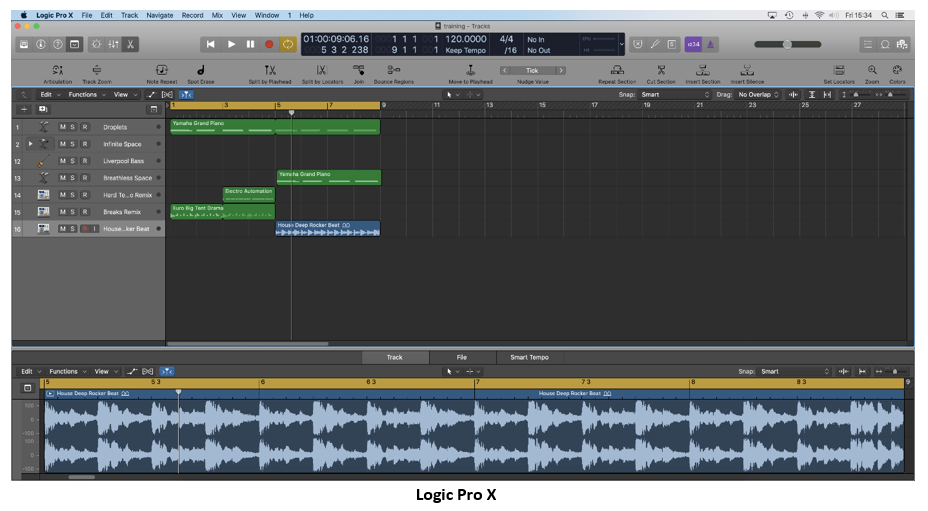Most people nowadays have many computers in their life integrated into everyday items such as phones, watches and washing machines. Back in the mid-80’s things were very different and the only computer in the house was a Sinclair Spectrum+ 48k Personal Computer.

My interest in computing and BASIC programming guided me towards Computer Studies as a G.C.S.E. ‘option’. Whilst flicking though some computer magazines in the school library, an advert for an interface caught my eye. The claim was that the interface would be able to transform the humble speccy into a music making machine. I was therefore thrilled to be bought a RAM Electronics Music Machine for my 15th birthday.
The interface had a number of uses but the main feature allowed the recording of musical notes into memory which could then be layered to create a song. It only took a few years for me to progress from the Sinclair Spectrum to a Commodore Amiga with a more advanced music production package called ‘Music X’.
In the early 1990’s there were three main options to consider when purchasing industry standard music software. Steinberg’s ‘Cubase’ was originally created for the Atari ST before becoming available on other platforms. Digidesign’s ‘Pro Tools’ was used in recording studios and only an option if you’d won the pools (the National Lottery didn’t start until late 1994). However, it was arrival of my Windows 3.1 PC with a professional music package called Emagic ‘Logic’ that changed everything for me.
I signed up for night classes at a technical college in order to get the most out of Logic. I enjoyed the course, but it was aimed more towards beginners as opposed to advanced users. As I acquired more synthesisers, much of my time was spent learning about synthesis with much less time devoted to creating songs. This led to my first hiatus away from using a computer to make music.
Apple acquired Emagic in 2002 and it took me 7 years to be able to obtain my own Mac Pro with a copy of ‘Logic Studio’. At this point many new features had been introduced including the recording of audio tracks. Many of the features remained the same and I was able to pick up from where I left off without consulting ‘the manual’.
The set of manuals originally provided by Logic Studio weighed about the same as two bricks and were worlds apart from the modern searchable PDF documentation that is prevalent nowadays.
Personal reasons combined with the complexity of my home studio led me to drift away from my hobby for a second time. Over the years my studio had organically grown to the point where it was too complex to use. In order to make any kind of music it took around 15 minutes to switch all the equipment on, by which time the creative juices had well and truly dried up.
Ten years on from when it was first acquired, my mac was no longer able to run Logic due to incompatibilities with the operating system. Therefore, if I did find some free time away from work and family commitments, I couldn’t use the software even if I’d wanted to.

During my time away Logic had changed quite dramatically to become Logic Pro X and I felt that to be able to get the best out of it I would need to go on a course.
My previous experience with instructor-led training had been very positive and so I initially looked to find a course similar to my very first Logic course. However, the landscape had changed in 15 years and now technical colleges were only offering night school courses such as French, Flower Arranging and Photography.
It wasn’t long until I noticed an advert on social media for an online music course. The irony was that as an Instructional Designer who had been creating bespoke Computer Based Training for many years, I should’ve instinctively sought out an online course from the start. However, I had a few reservations as there is something very reassuring having an instructor in the classroom with you, especially during practical tasks.
I managed to find an online platform aimed at professional adults and students and started my course ‘Music production in Logic Pro X – the complete course’. The course was entirely video based, in some sections the instructor would talk to camera and then in others a voiceover was layered over a screen capture of ‘Logic Pro X’ in action.

Logic Pro X
It was broken down into 50 ‘sections’ each containing a number of ‘lectures’ ranging in length from 2 mins to 20 mins. The course comprised 403 lectures split across 43 hours of video and even the most ardent boxset binge watcher would be hard-pressed to complete it in a week.
Engineering and aviation-based courses must ensure that all safety critical aspects are covered and understood. However, due to the light-hearted nature of my course, I was given total access to the course structure, with the ability to jump to any lecture in any order.
Even though I had the ability to jump around randomly, a sense of curiosity combined with the fear of missing out ensured that I progressed through the course in order. I found that some lectures weren’t teaching me anything new and so I used a YouTube style video control bar to skip through familiar material. The LMS, used to manage the course was both powerful and intuitive and gave me regular updates of how far I was throughout the course. This was also reflected as ticks against the main course structure.
The interface of any Computer Based Training should be unobtrusive so as not to detract from the material. Controls for different playback speeds, Closed Captions, bookmarking and a transcript were available throughout but faded into the background when not in use. This is a very familiar format for anyone who uses platforms such as Netflix and Amazon Prime.
The major downside of the course was its lack of interaction. Additional downloadable PDF documents were provided to provide additional research. However, a good instructor can inspire students by getting them involved and drawing them in which could’ve easily been achieved by using downloadable practical tasks. To its credit, the LMS did provide context sensitive Q&A feedback where if you had a question that had not previously been asked you could have it answered in a relatively short timeframe.
As a motivated learner it was possible to pause each lecture at any point and switch windows into Logic in order to experiment with the concepts being taught.
At the time of writing this article I had completed the parts of the course required to get the most out of Logic Pro X. However, I am looking forward to completing the entire course in order go into some of the more in-depth music production techniques that may be of use to me in the future. I will then also be issued with a certificate.
I found that this style of teaching was able to offer me the instructor-driven parrot-fashion training that I am comfortable with (as opposed to consulting a large manual) with the additional benefits of being able to fit it around my own spare time in the comfort of my own home.
There will always be benefits to traditional learning such as:
- A highly skilled instructor can adapt the information for the audience in real-time
- Students can learn from one another
- Collaborative environment
- Instructor can monitor the correct execution of practical tasks
However, I would urge anyone to try an online course if they haven’t already – you never know what you might learn.
